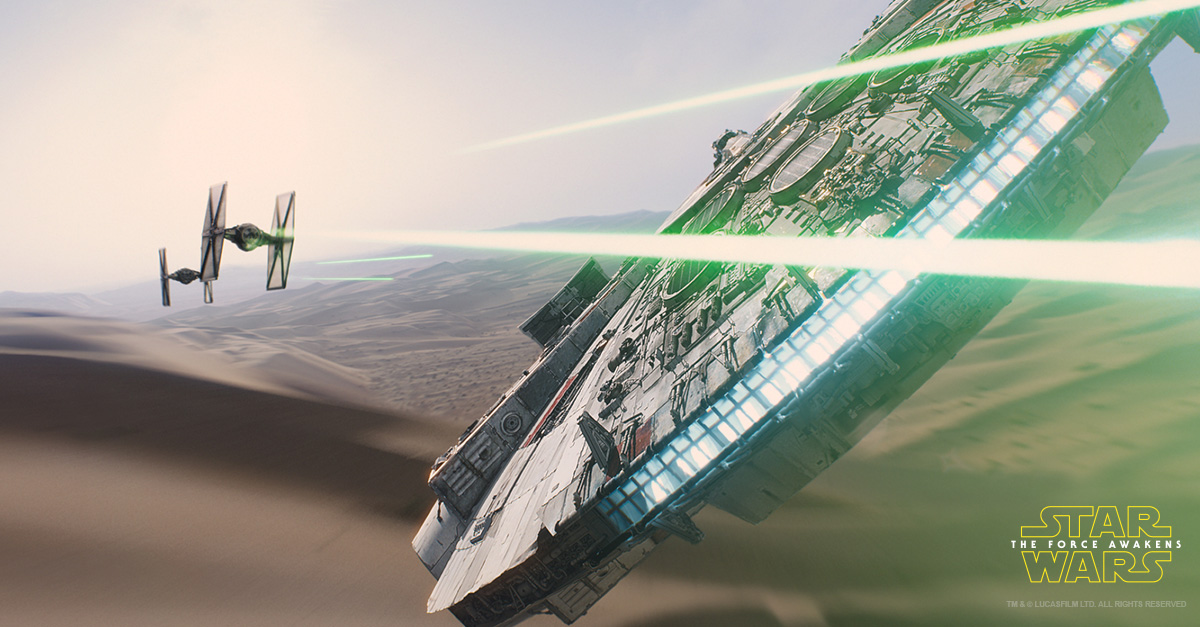
INTRODUCTION
These articles often attract people who don't usually come to the site, so it is worth an introduction. I’ve been writing for Ain’t It Cool for a long time, but I’m also a professor of astrophysics at the University of California, Santa Barbara, and a staff scientist at the Las Cumbres Observatory Global Telescope Network. I often write about the science in movies, and just recently we made the first video version of one of these articles, Science vs. Cinema: THE MARTIAN. It already has more than 400,000 videos on YouTube, and we’re trying to get it turned into a TV show. We’d like to make one of those based on this article, but we’ll see if all the pieces come together.
Long-time readers of the site know I’m a huge STAR WARS fan — the original is my favorite movie of all time. It is the main reason I became a professional astronomer. So *of course* I was going to write an article on the science of THE FORCE AWAKENS. After all, I’d written an article about the Science of STAR WARS. And I’ve been interviewed for a few articles about the science of THE FORCE AWAKENS, including this one in the Daily Dot, and another one in a German magazine.
Yes, I’m aware that STAR WARS is space fantasy. Still, there are plenty of reasons to do an article like this. Almost everyone knows Star Wars. In fact, since we first see it as kids, it is often our first exposure to astronomy. This is a blessing and a curse. It can inspire us to become scientists and engineers, and lead us to develop new technology. But where the films get the science wrong, they can engender misconceptions. However, we can use our shared cultural knowledge of the films as a jumping off point to study some pretty cool related things in the universe, which are often more profound and unbelievable than any author would have the audacity to write.
The purpose of these articles is not to nitpick. On the contrary, it is to inspire and transmit cool ideas. And of course there is always a little bit of keeping people who make movies honest.
And for what it’s worth, I really liked THE FORCE AWAKENS. I loved the new characters, and the actors portraying them are outstanding. And of course, seeing some of my favorite heroes on screen again after all these years was a dream come true. And it just felt true to the magic of the original STAR WARS trilogy in a way that the prequels didn’t. That’s no easy feat. Still, I had the same issues that everyone did — it was too derivative, for a start. But I had the extra heartache of having to deal with some unnecessary astrophysical nonsense. Having said all that, I’ve seen in four times, so I’m kind of like the guy in the Onion article who has seen THE FORCE AWAKENS six times, and thinks it is just “pretty good.”
I wrote so much on Starkiller base (where most of the problems are), that I’ve split that into a separate article. Here in Part 1, I’ll cover everything else. As always, I’ve liberally sprinkled links throughout the article, so if a subject catches your attention, click through to read more. Let’s start with everyone’s new favorite astromech droid!
BB-8
Wow, the team behind THE FORCE AWAKENS really hit it out of the park with BB-8. Attempts to consciously create a “cute” sidekick almost always backfire (see: Batmite, the great Gazoo, Scrappy Doo, Jar Jar, Poochie). But BB-8 has that perfect mix of being tiny, loyal, endearing, smart, tough, and relatable. How does he work?
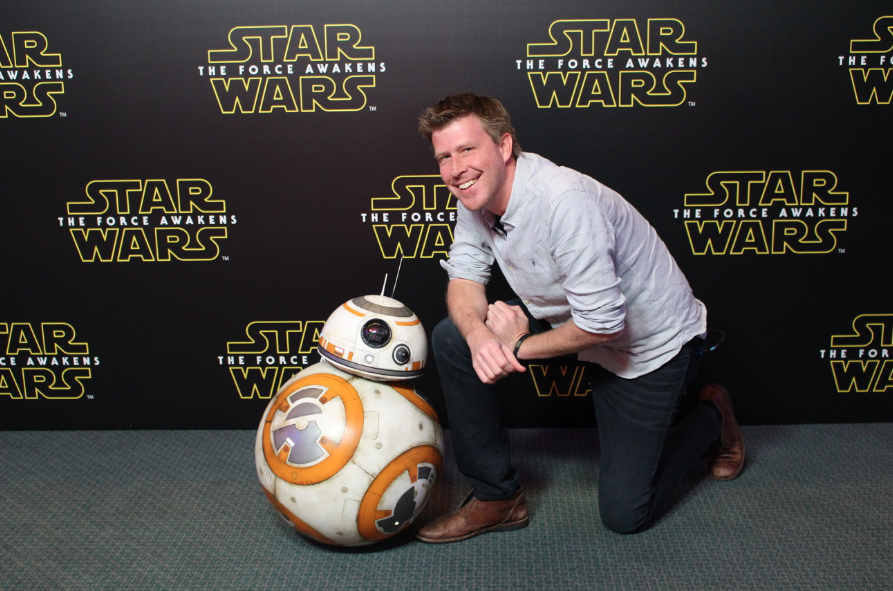
Indeed there are real-world, full-sized working models of BB-8, and I was able to interact with one at the FORCE AWAKENS press conference last year, as you can see above. That thing is pure magic, and I saw dozens of cynical journalists overflowing with glee at just the sight of it. However, the fully robotic version was only finished after filming was complete. Instead, the on-screen performance was achieved through a combination of puppets, simplified robotics, and computer graphics. There were a variety of models used depending on the needs in that particular scene.
The idea of an omnidirectional robot — one that doesn’t have to change orientation before moving in a new direction — has been around for a long time. These are called holonomic robots. And indeed the patent for an omnidirectional robot ball was filed by people at Disney back in 2010, more than two years before Disney acquired Lucasfilm. Then in 2011 Sphero demonstrated a remote controlled ball robot. It isn’t clear that JJ Abrams knew any of this when he supposedly sketched an idea for BB-8 on a napkin. After the initial idea, as this article points out, Lucasfilm concept designers Christian Alzmann and Jake Lunt Davies refined the design. Then it was up to Neal Scanlan’s creature shop to bring it to life. Joshua Lee made a puppet version, and from this the team determined that BB-8 could be a practical effect. Matthew Denton then made other animatronic versions. Some could just spin on the spot. Others could be remote controlled, but had extra stabilizer wheels. But BB-8 really came alive through the puppetry of Dave Chapman and Brian Herring, who controlled the head and body separately. After filming, the puppeteers and their footprints, were digitally erased from the shots. All in all, there were something like a half-dozen different versions of BB-8. For the scenes with the robotic arm, CG was used, as you can see in this video.
Now you can even buy a toy version of BB-8 from Sphero! That’s incredible! If you want to see how it works, check out this Tested video where they took one apart and put it into a clear sphere. Lucasfilm hasn’t said publicly how the full-sized robotic BB-8 works, but this site has a few theories and diagrams. There’s even a BB-8 builder’s club!
The basic idea is that there is a chassis inside the body that stays fixed, while wheels spin the body. A mast then extends up and moves the head, which is on wheels and held down by magnets. The real trick is to keep some things aligned while others are rotating. To that, you use gyroscopes. A mechanical gyroscope is a rotating wheel inside a set of gimbals. Due to conservation of angular momentum, once you start a wheel spinning, it wants to keep spinning in that direction. It is just like regular momentum, only the spinny version. Gyroscopes are useful for all sorts of things, not the least of which is to maintain the orientation of the Hubble Space Telescope.
There are also microelectromechanical (MEMS) gyroscopes — the things that allow your phone to sense where it is pointing. They have tiny little vibrating structures, which want to keep vibrating in the same plane. As you move your phone around, this produces a force on the support to the vibrating structure, which can be measured to determine the rotation rate. Some insects even have similar vibrating structures called halteres, which allow them to sense rotations. This has evolved at least twice in different ways, and is a cool example of convergent evolution.
Gyroscopes and magnets are two of the most magical-seeming physics principles. They produce effects that seem to arise out of nowhere. Maybe because we didn’t evolve to have them in our bodies, we didn’t evolve any intuition about them. After all, nature never evolved wheels. I think that’s one reason BB-8 seems at once magical and technical — he’s a rolling ball of weird physics. Magical with a dusting of technical is the pure essence of STAR WARS.
UNGREASED LIGHTNING
Kylo Ren freezing a blaster shot in midair, and doing it so casually, while interrogating a prisoner, is one of those “holy shit!” iconic moments that defines a villain. Think about how many things it establishes in just a moment: (1) you can’t surprise him; (2) he’s happy to torture people to get what he wants; (3) he’s been studying the Dark Side so much that he took Vader’s arresting-blaster-fire move and one-upped it; and (4) it is no big deal, he can do it while multitasking. Now that’s economic storytelling! And aside from the storytelling angle, I think it tells us more about something I’ve always been curious about — how blaster bolts work in the STAR WARS universe.
I don’t think they ever call the things that blasters and ships fire “lasers” in any STAR WARS movie. (They do sometimes call big cannons “turbolasers,” but that could mean anything). It is easy to see why they are always called blasters — blaster bolts have very different properties than lasers.
Lasers on Earth are a continuous stream of photons. But they have the peculiar property that all the photons are at nearly the same wavelength (i.e. the same color), and they are in-phase, meaning the waves wiggle together, and not randomly. This is what lets lasers do their magic — they can put a lot of light in a small space. But they don’t work like blasters — you can only see lasers from the side if they are in a scattering medium (like a smoke-filled room, or the dusty atmosphere), and some of them scatter out of the forward traveling direction towards you. Even if you pulsed a laser, you wouldn’t see little bolts like we do in STAR WARS, because each packet of photons is traveling at the speed of light — far faster than your eyes could track it. Lasers also don’t make sound. Having said all that, if you do want to see the closest thing that researchers have created to real-life STAR WARS lasers, check out this pretty cool link.
Incidentally, even though lasers move at nature’s ultimate speed limit, the “speed of light” is not exactly a constant, but an upper limit. The speed of light in air is about 90 km/s slower than it is in a vacuum. Researchers have even slowed light down to an effective standstill in the lab, as you can read about here. This amounts more to a form of trickery where the information in a laser pulse is encoded in some atoms and then reconstituted. Still, these advances could be useful in quantum communications and information storage.
In STAR WARS blasters fire laser bolts, something more akin to a crossbow bolt or lightening bolt than a laser. This gloriously nerdy post over at Wired analyzed the speed of blaster fire and concluded that in the STAR WARS universe, blaster bolts move about as fast as a slowly pitched baseball. No wonder Jedis can bat them with lightsabers.
So what are blaster bolts made of? It isn’t really clear. They don’t seem to be some super-hot physical projectile. Maybe they are self-contained plasma, akin to a lightsaber, only at much lower energies. A plasma is just charged particles, so I’d buy that Kylo Ren could stop them mid-flight given that we’ve seen other Jedi and Sith Lords move things with their mind. However, just like a bullet, a blaster bolt ought to fall to the ground once stopped. Bullets shot parallel to the ground fall to the Earth at the same rate no matter if you just dropped one or shot it. That means Kylo Ren held it in midair there, and then accelerated it back to blaster-bolt speed with his mind, just for effect! That tells us a fifth thing about him — he’s kind of a showoff, and maybe a little insecure, since feels the need to torture someone so flamboyantly. He doesn’t just cause people pain before he kills them, he’s also a dick about it. He’s the Martin Shkreli of Star Wars villains.
WONDER BREAD
On Jakku, when Rey is making dinner, she puts some kind of powder into a liquid, and boom, in seconds it turns into something that looks like a loaf of bread. I love this! It is one of those cool little details that just sells the universe. Again, technical magic just beyond what we can currently do. It is something we don’t have, but seems like something we could.

Believe it or not, that shot was done with practical effects! I have no idea how — I’d watch a featurette on just that. Apparently it took them about 3 months to perfect it.
While we don’t have instant bread yet, this seems so perfect because it operates kind of similarly to other things we do have. Astronaut food is often reconstituted by adding hot water. And some of it is pretty delicious — I got to taste some when I visited the NASA food lab and filmed a scene with Mike Massimino for Known Universe. That scene never aired, but I sure learned a lot about astronaut food. For example, they don’t actually take bread to space, because it gets crumbs everywhere. Instead, they use tortillas. They also don’t drink carbonated beverages, because gravity doesn’t separate gas from liquid in your gut. The resulting “wet burps,” are like little vomits. Gross.
PUT A RING ON IT
The rebel base has a pretty big ring around it. It sure looks cool, but is it realistic? The short answer is kind of, but not really. The physics behind it is fascinating, so it is worth going into a bit.
All the big planets in the solar system have rings to some extent or another. Of course Saturn’s are the most spectacular and well known. The rings around Jupiter, Neptune, and Uranus are much more diffuse and hard to see, but they’re clearly there — here’s a picture of Jupiter’s rings taken by the Galileo spacecraft.
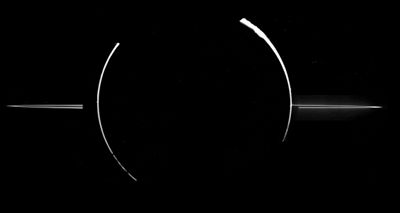
The reason they have rings is that they have such strong gravity that tidal forces rip apart anything that gets too close to them. The gravity on the near side of some body in orbit is so much stronger than on the far side, that the object is pulled apart. Big things like moons get pulverized if they are within a certain radius of the planet. This “point of no return” is called the Roche limit. Big moons can survive beyond it, but if you get closer to the planet than the limit, you’re crushed. Rings are made of just this debris! They are particles with a size distribution from small moon-sized down to smoke-like particles.
Big planets have a few things going for them when making rings. Their strong gravity allows them to capture many comets or asteroids, giving them lots of raw material to crush into rings. Also, their Roche limit is far out so that things don’t have to get all that close to the planet before they are pulverized. You can see this at work in our solar system — all the gas giants in the solar system have rings. None of the terrestrial (Earthlike) planets do.
But in THE FORCE AWAKENS, the resistance base isn’t on a gas-giant planet — it is on a smaller planet with a solid surface. Since our heroes walk around on it normally, we can be sure that it has Earthlike gravity, and isn’t too different from Earth in size. Theoretically, terrestrial planets can have rings, but the rings have to be really close. The Roche limit for a body the density of the moon in orbit around Earth is 2.8 times the radius of the Earth. But in THE FORCE AWAKENS, it looked like the rings were pretty far out. Implausible, yes, but not a deal-breaker. We know there are planet and moon destroying technologies in the STAR WARS universe, so those rings might not even have been made from natural forces.
Instead, my main problem with the rings in TFA is that they are too chunky. The rings are filled with massive things from the size of moonlets to huge boulders. The particles in the rings of Saturn have been measured to have what’s called a power law distribution. In this case the number of particles at a given size is inversely proportional to the cube of the size of the particle. So for every 100 meter boulder, there are a thousand 10 meter rocks, a million 1 meter rocks, a trillion 1 centimeter pebbles, and a trillion trillion snowflake-sized particles. In other words, boulder or moon sized things are exceedingly rare.
So the rings in THE FORCE AWAKENS are really weird. I bet the artist who designed them subconsciously realized this. It is exactly this weirdness that makes them seem otherworldly. I’d love to know whether they were just drawn like a matte painting or whether there was a program to create them, and if so what the particle size distribution was.
This isn’t really a big deal. I do get irked a little when I see those rings, but I realize that I’m one of maybe 100 people in the world who would react that way. I just wanted to use this as an excuse to talk about rings!
KESSEL RUN
In THE FORCE AWAKENS, Rey mentions that Han Solo made the Kessel run in less than 14 parsecs, which Solo corrects to 12 parsecs. Ugh. I really hate lines like this — they could have picked any throwaway line from the trilogy, but Abrams and Kasdan instead chose to double down on one of the dumbest lines in Star Wars history.
A parsec is a unit of distance, not time. It is confusing though, because it was formed from “parallax second” — the distance a star would have to be for a star to trace out a loop on the sky of one arcsecond (1/3600 of a degree) radius due to parallax when seen from Earth. If you want details, I explained it more in my SCIENCE OF STAR WARS piece.
Expanded universe authors have retconned this mistake by saying that the Kessel Run is a race that needs to be run in the shortest distance, not time. I think the first mention was circa 1997 in the A. C. Crispin Han Solo Trilogy.
Mistaking parsecs as a unit of time is a common misconception — I see it all the time in my introductory astronomy classes. In fact, the original STAR WARS teaser trailer had another version of this same mistake! It called the movie, “light years ahead of its time.” George Lucas would certainly have had to have approve that, so it is pretty clear he didn’t have the best understanding of astronomical distance units. These mistakes were even more common in he past when there was no worldwide web to easily look up the meaning.
There is further evidence that this was a mistake — in the novelization (ghostwritten by Alan Dean Foster, but approved by Lucas), the brag was changed to “12 standard time units.” Note that it says time, not distance. And there’s another reason parsecs make no sense — why would they use a unit based on Earth in “a galaxy far, far away?”
Some say that based on Ben’s reaction, he knew Han was full of it. The fourth draft of the STAR WARS script says: “Ben reacts to Solo’s stupid attempt to impress them with obvious misinformation.” Some have taken that to mean that Han Solo just didn’t know what a parsec was. It seems idiotic to me that a starship captain wouldn’t know how to measure distance. Others say that he knew, but was just deliberately using the wrong term to Ben and Luke. That also seems dumb — why make up something wrong, when you are trying to convince people that you are an expert? Instead, there is only one interpretation of that scene that makes sense to me — Lucas wanted to indicate that Solo was exaggerating, but also didn’t realize what a parsec is.
Well, now with the new line in THE FORCE AWAKENS, it is tough to say that Han Solo either didn’t know what he was talking about, or just made up something on the spot, as he repeats the 12 parsec line here. Also, Rey uses the term too, indicating that people all across the galaxy use the term in a similar way. Sigh, it is sad to see that Kasdan and Abrams seem to now be making the EU retcon official, and in the process propagating a misconception about parsecs for a new generation of fans. STAR WARS getting astronomy wrong for no reason makes me sad. Reveling in it is even worse.
JJ ABRAMS DOESN’T UNDERSTAND INTERSTELLAR DISTANCES
After Rey and Finn escape from Jakku in the Millennium Falcon, they don’t appear to go into hyperspace. They run into mechanical problems, discuss where they should go, and immediately get boarded by Han and Chewie. While it is possible they could have gone into hyperspace off-screen, it doesn’t seem they did. When they ultimately do go into hyperspace there is a big discussion about whether the Falcon is ready for it, because of all the crap that Unkar Plutt did to the ship. And of course, going into hyperspace does then cause problems, implying that this is the first time they’ve done it.
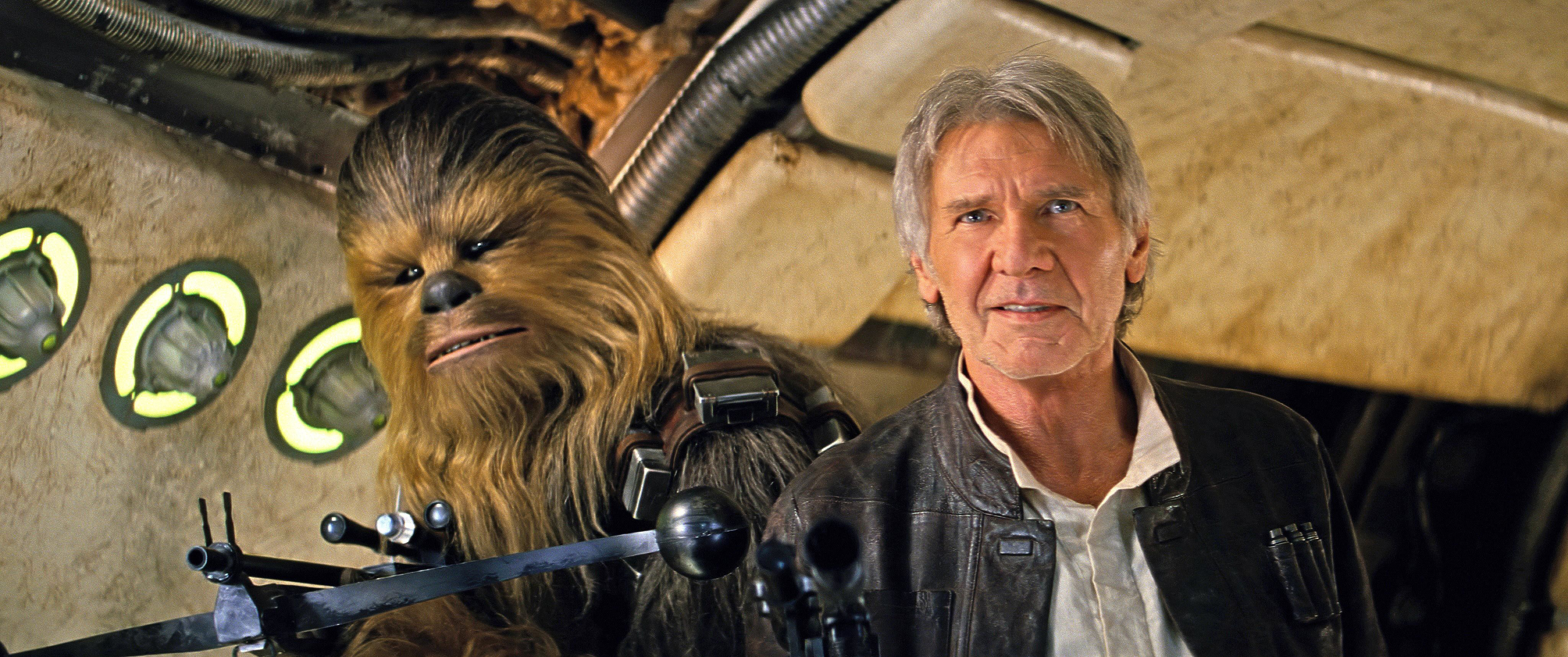
There’s one big problem with this. If they never went into hyperspace, they didn’t get very far. Since the Falcon’s non-hyperdrive engines are “sublight,” the ship travels slower than the speed of light when using them. To give you a sense of how big a star system is: Voyager 1 just left our own solar system, and it takes light about 18 hours to reach it. And it takes light 4 years to reach the next nearest star system. It seems that Rey and Finn were only traveling for minutes. That means they still have to be in the Jakku system when Han and Chewie pick them up.
That’s all fine, but the problem comes in the dialog surrounding this. An officer tells Kylo Ren that the rebels have escaped Jakku, implying that they have escaped the system. But when the officer was telling Kylo Ren this, Rey and Finn were still right there, trying to make the world’s slowest getaway.
But it gets worse! When Han asked where they got the Falcon, upon hearing that it was Jakku, he complained that they should have made their way out to that region of the galaxy. But HE’S RIGHT THERE in the Jakku system! He could have looked out the window, and said, “Oh, you mean THAT planet?”
This just makes no damn sense. The only solution (which still doesn’t work) is that Rey and Finn went to hyperspace for a offscreen for a few minutes just to put some distance between them and Jakku, before stopping to fix the ship. Then she inexplicably neglects to tell Han this when they are discussing what needs to be done before they take the Falcon to hyperspace. He could figure this out though — if Rey and Finn picked up the ship in Jakku, and they aren’t there now, at some point they went to hyperspace.
So the real answer is that JJ Abrams doesn’t understand basic astronomy. We already had evidence of this in STAR TREK, when there is a supernova that threatens planets across multiple star systems (ludicrous), and there’s plenty more evidence later in THE FORCE AWAKENS. Just see the next section!
SEEING THINGS
Our heroes are on Maz Kanata’s planet, Takodana, and they look up, and watch the destruction of all the planets in a whole different star system — the *Hosnian* system — *right there in the freakin’ sky* of Takodana. Jesus Christ in a breadbasket, JJ Abrams, you can’t look up in the sky, and see what’s happening to planets half a galaxy away! PLANETS AROUND ANOTHER STAR CAN’T BE SEEN IN YOUR SKY. If so, it wouldn’t have taken humanity 200,000 years to find extrasolar planets. This is the absolute dumbest thing about THE FORCE AWAKENS, because there is no amount of retconning or technology in the Star Wars universe that can get you out of it. And it is completely unnecessary from a storytelling perspective. It is pure ignorance and misconception passed onto a billion people.
Our heroes see a few beams from Starkiller base streaking across the sky, then blowing up a series of planets spread across a few degrees in the sky. To explore this, we need to talk about angular size. That’s the angle some astronomical body makes on the sky. The sky is 180 degrees across, half a sphere. If you hold out your fist at arm’s length it subtends an angle of about 10 degrees. You finger sideways — 1 degree. The Sun and the Moon are both about half a degree across. The planets in our solar system are at most about an arcminute in diameter — that’s 1/60th of a degree. That’s small enough that your eye can’t make out details, but you can in a telescope. Other stars though are just point sources. You can’t resolve the vast majority of them, even with the world’s largest telescopes. Planets around other stars also subtend unimaginably tiny angles. They are so small that you can’t separate the light of the planet and the light from the star.
And yet, when our heroes look up, they see planets from an entirely different star system getting destroyed, scattered for degrees across the sky! All of this should have been happening in a single point of light. This is like looking out your door in Chicago, and being able to make out the Eiffel tower in Paris.
Even from an in-universe consistency perspective, they shouldn’t even have been able to see the beam of the superweapon as it travels through hyperspace. In our space, you can’t see anything else that travels through hyperspace. This is a major plot point in earlier films — the Empire loses the Millennium Falcon when it makes the jump. That’s the whole point of hyperspace — it is a different dimension.
Also, planets blowing up would never make explosions bright enough to see across the galaxy. Even explosions on stars, such as novae almost never can be seen with the naked eye, much less during the daytime.
The only way that whole scene sort of makes sense is if Maz’ planet is in the Hosnian system. Unfortunately, we know it isn’t. For a start, it was clear they were blowing up all the planets in the Hosnian system, since that was the seat of government. No self-respecting den of pirates would be in the capital. Second, there is this official map. See how far apart those stars are?
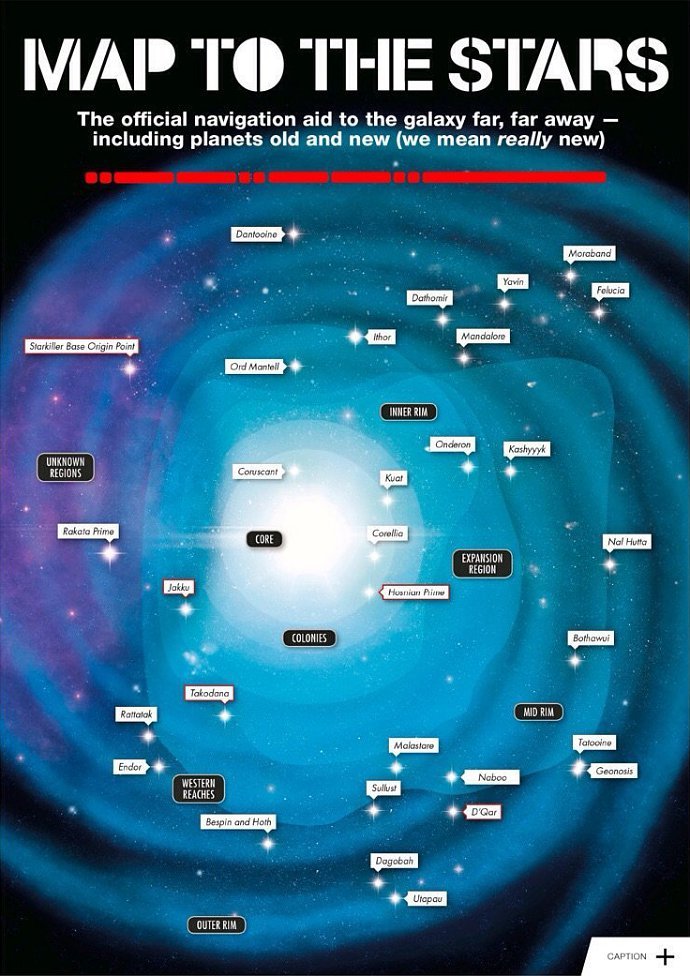
Note that in the night sky, you can only see stars a few hundred lightyears away, maybe a thousand or so for really bright stars. And yet the galaxy is a hundred thousand lightyears across. We can only see a teeny tiny little corner of our galaxy. It is bullshit to look up in the sky and even see the parent star of a planet all the way across the galaxy.
And there’s another *huge* problem here. It would take thousands of years for the light to travel to you from so far away. According to that map, maybe 10,000 years. Even if the star were right next door, it would still take years.
Abrams made the same error in the 2009 STAR TREK. There Spock looked up and watched the destruction of Vulcan from an entirely different planet. You can see my take on that here. And the thing is, both times it was completely unnecessary. In THE FORCE AWAKENS all they had to do was have some character explain that the seat of government had blown up, have someone feel a disturbance in the force, or watch a holo-report of it. All these things have been used in the past to indicate such things because EVEN GEORGE LUCAS THE PARSEC-CHALLENGED UNDERSTANDS INTERGALACTIC DISTANCES BETTER THAN JJ ABRAMS.
The even-more-maddening thing is that JJ Abrams not only repeated the same mistake about what you can see in the sky, he also ripped off his own previous worst idea from STAR TREK to recycle here. In STAR TREK there it was an howlingly ridiculous supernova that could somehow destroy planets around different stars by traveling faster than the speed of light. This is my biggest problem with Starkiller base: destroying one planet is all the threat you need. Having it destroy many, but from really far away adds nothing to the danger, but it puts the stupidity factor through the roof.
More on Starkiller Base in Part 2.
WRAP UP
That’s it for Part 1. In short, I loved BB-8 and the instant bread. They add magic and wonder to the universe and seem just beyond what we’re capable of. Kylo Ren’s freezing the lightning bolt is equally cool. It is great storytelling, and is plausible given the rules of the universe we know. The rings not looking right doesn’t really matter one way or another. But the real tragedy of THE FORCE AWAKENS is that JJ Abrams’ astronomical misconceptions made their way into the film. Both the escape from Jakku and watching the destruction of the Hosnian system, are major failures of astronomical understanding. But just wait, it gets worse. Starkiller base almost gave me a brain hemorrhage. That whole sad story is told in Part 2
